

EXPLORE BY TOPIC:
  Our top 10 resources
Our top 10 resources
  Childhood / Early Life
Childhood / Early Life
  Chronic Stress
Chronic Stress
  Education
Education
  Food Security
Food Security
  Genetics
Genetics
  Jobs & Work
Jobs & Work
  Housing / Neighborhoods
Housing / Neighborhoods
  Income & Wealth
Income & Wealth
  Race / Racism
Race / Racism
  Social Inclusion
Social Inclusion
  Policy & Change
Policy & Change





Buy the DVD
e-Newsletter
FAQs
Contact Us
Site Map
Home

|
 |


|
|
| |
|
Keyword=EP_5: 0 items found |
 Smart Growth Online Smart Growth Online 
WEB SITE In 1996, the U.S. Environmental Protection Agency joined with several non-profit and government organizations to form the Smart Growth Network (SGN). The Network was formed in response to increasing community concerns about the need for new ways to grow that boost the economy, protect the environment, and enhance community vitality. The Network's partners include environmental groups, historic preservation organizations, professional organizations, developers, real estate interests; local and state government entities. |
 |
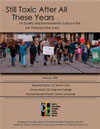 Still Toxic After All These Years: Air Quality and Environmental Justice in the San Francisco Bay Area (pdf) Still Toxic After All These Years: Air Quality and Environmental Justice in the San Francisco Bay Area (pdf) 
REPORT by the Center for Justice, Tolerance, & Community, UC Santa Cruz From West Oakland's diesel-choked neighborhoods to San Francisco's traffic-snarled Mission District to the fenceline communities abutting Richmond's refineries, poor and minority residents of the San Francisco Bay Area get more than their share of exposure to air pollution and environmental hazards, this report finds. |
 |
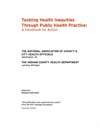 Tackling the Root Causes of Health Disparities Through Community Capacity Building (pdf) Tackling the Root Causes of Health Disparities Through Community Capacity Building (pdf) 
ARTICLE by Anthony Iton. Chapter in Tackling Health Inequities Through Public Health Practice: A Handbook for Action Iton explains how legacies of structural poverty, instituional racism, and other systemic injustices shape the environment in which all public health efforts take place. Thus, to successfully address a community's health, public health workers and policy officials need to take such factors into account, and design their interventions based on the particular strengths and needs of each community, and build partnerships as much as possible with community members, advocates, activists and other stakeholders. Successful public health action depend ultimately on the empowerment of the community itself. |
 |
 The biggest asthma trigger of them all? New studies indicate how poverty itself Is inflammatory The biggest asthma trigger of them all? New studies indicate how poverty itself Is inflammatory 
Edith Chen, Ph.D at the Psychobiological Determinants of Health Lab at the University of British Columbia Scientists such as Edith Chen, Ph.D, have found evidence that the very experience of poverty and the stress it induces might itself be an asthma “trigger.” Dr. Chen co-founded the Psychobiological Determinants of Health Lab at the University of British Columbia to better understand the pathways by which class gets under the skin and influences our heath. Rather than focus on how material pollutants, like soot, disrupt our physiology Chen and her colleagues are investigating how ‘social pollutants’ – that is, toxic social environments can become embedded in our bodies and increase susceptibility to disease. |
 |
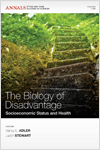 The Biology of Disadvantage: Socioeconomic Status and Health The Biology of Disadvantage: Socioeconomic Status and Health 
JOURNAL Nancy E. Adler and Judith Stewart, eds. Annals of the New York Academy of Science How does socioeconomic status get under the skin? This book summarizes the decade of research by the MacArthur Foundation Research Network on Socioeconomic Status and Health “exploring the pathways and mechanisms that contribute to the gradient relationship between socioeconomic status and health.”
PDFs of each article are available online. You may also purchase a complete copy of the journal.
|
 |
 The Funders Network The Funders Network 
WEB SITE The Funders’ Network for Smart Growth and Livable Communities brings together foundations, nonprofit organizations and other partners to address the range of environmental, social, and economic problems caused by development strategies that fail to consider the big picture. Their Web site's resource section contains public documents published by the Funders' Network, as well as materials and information produced by other organizations, and links to selected community development organizations. |
 |
 The Perfect Neighborhood The Perfect Neighborhood 
ONLINE INTERACTIVITY based on UNNATURAL CAUSES What comes to mind when you think of a healthy neighborhood? What does it take to make a neighborhood more healthy? Find out why conditions in some communities might be less favorable to health than others and what can be done to change them. |
 |
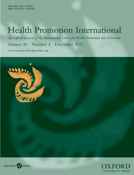 The Political Economy of Health Promotion: Part 2 - National Provision of the Prerequisites of Health The Political Economy of Health Promotion: Part 2 - National Provision of the Prerequisites of Health 
ARTICLE by Dennis Raphael, Health Promotion International, Dec 2011 Part 2 of two-part article published in Dec 2011 issue of Health Promotion International. Part 2 of this article documents the extent to which public policy activity that provides the prerequisites of health through public policy action differs among varying welfare state regimes. |
 |
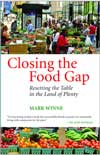 The Poor Get Diabetes, the Rich Get Local and Organic The Poor Get Diabetes, the Rich Get Local and Organic 
ARTICLE by Mark Winne In this excerpt from his new book, Closing the Food Gap: Resetting the Table in the Land of Plenty, Mark Winne explains a growing split in the diets of the haves and have-nots; at the same time that the wealthy are coming to prefer organic and locally-grown foods, the poor have been losing geographical and economic access to healthy options. He also reports on a survey by the non-profit group Hartford Food System, which found that low-income consumers in the area would prefer to purchase organics and fresh foods, but simply couldn't access or afford them. |
 |
 The Praxis Project The Praxis Project 
WEB SITE The Praxis Project is a national, nonprofit organization that builds partnerships with local groups to influence policymaking to address the underlying, systemic causes of community problems. Committed to closing the health gap facing communities of color, they forge alliances for building healthy communities. Praxis trains its partner organizations and provides research, technical assistance and financial support to tackle issues impacting the well being of communities. Their site contains an information resource center with additional resources and reports on equity and social justice. |
 |
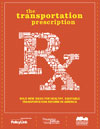 The Transportation Prescription: Bold New Ideas for Healthy, Equitable Transportation Reform in America (pdf) The Transportation Prescription: Bold New Ideas for Healthy, Equitable Transportation Reform in America (pdf) 
REPORT from PolicyLink, Prevention Institute, and the Convergence Partnership, 2009
This report synthesizes the insights and recommendations of a group of leading academic researchers and advocates working at the intersection of transportation policy, equity, and public health identify opportunities for creating transportation systems that promote health and equity.
|
 |
 THRIVE: The Tool for Health and Resilience in Vulnerable Environments THRIVE: The Tool for Health and Resilience in Vulnerable Environments 
WEB SITE THRIVE is a tool developed by the Prevention Institute to help you understand and prioritize the factors within your own community that can help improve health and safety. The tool can help answer questions such as: How can I identify key factors in my community and rate their importance? How are these factors related to health outcomes? What can I do to address each factor? Where can I go for more information? |
 |
 Too Young to Die: Part 1, Life's Toll Too Young to Die: Part 1, Life's Toll 
NEWS ARTICLE, San Francisco Chronicle, October 2004 In Bayview-Hunters Point, the stress created by environmental problems, racism, poverty and crime may explain why so many babies die young. Infant mortality is twice as high here as in the rest of San Francisco.
|
 |
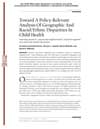 Toward A Policy-Relevant Analysis Of Geographic And Racial/Ethnic Disparities In Child Health Toward A Policy-Relevant Analysis Of Geographic And Racial/Ethnic Disparities In Child Health 
SCHOLARLY ARTICLE by Acevedo-Garcia, Osypuk, McArdle and Williams, 2008 Extreme racial/ethnic disparities exist in children’s access to "opportunity neighborhoods." We need to move beyond conventional public health and health care approaches to consider policies to improve access to opportunity-rich neighborhoods through enhanced housing mobility, and to increase the opportunities for healthy living in disadvantaged neighborhoods. |
 |
 Toxic Wastes and Race Revisited (pdf) Toxic Wastes and Race Revisited (pdf) 
REPORT by Benjamin A. Goldman and Laura J. Fitton, 1994 An update on the 1987 report on the racial and socioeconomic characteristics of communities with hazardous waste sites. Co-sponsored by Center for Policy Alternatives, NAACP, and United Church of Christ Commission for Racial Justice |
 |
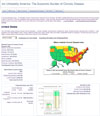 Unhealthy America: The Economic Burden of Chronic Disease Unhealthy America: The Economic Burden of Chronic Disease 
WEBSITE by The Milken Institute This interactive website provides a wealth of information on the rates and costs of chronic disease broken down by geography and disease. In its groundbreaking study, “An Unhealthy America: The Economic Impact of Chronic Disease,” the Milken Institute details the enormous financial impact of chronic disease on the U.S. economy – not only in treatment costs, but lost worker productivity – today and in the decades ahead. It also describes the huge savings if a serious effort were made to improve Americans’ health. |
 |
 Urban Settings (pdf) Urban Settings (pdf) 
REPORT from the WHO Commission on the Social Determinants of Health, 2007
Focuses on urbanizations, particularly broad policy interventions related to healthy urbanization, and closely examines slum upgrading.
This is an interim report, submitted by the Urban Settings Knowledge Network to develop the Commission's final report in May 2008.
|
 |
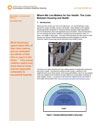 Where We Live Matters for Our Health: The Links Between Housing and Health Where We Live Matters for Our Health: The Links Between Housing and Health 
REPORT by the RWJF Commission to Build a Healthier America, Oct 2008
This issue brief focuses on three important and inter-related aspects of residential housing and their links to health: the physical conditions within homes; conditions in the neighborhoods surrounding homes; and housing affordability, which not only shapes home and neighborhood conditions but also affects the overall ability of families to make healthy choices. |
 |
 Why Place & Race Matter: Impacting health through a Focus on Race and Place Why Place & Race Matter: Impacting health through a Focus on Race and Place 
PolicyLink This report builds on PolicyLink's earlier work to look more intentionally and explicitly at race and ethnicity and what they mean in the context of building healthy communities. "Why Place and Race Matter" dives deeply into these issues and profiles dynamic groups and initiatives throughout California and beyond. Although approaches vary, each illuminates the interplay among people, place, and race. We hope these strategies and profiles will facilitate the exchange of ideas, encourage partnerships across disciplines and sectors, and stimulate action to build healthy communities. |
 |
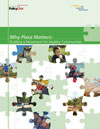 Why Place Matters: Building a Movement for Healthy Communities (pdf) Why Place Matters: Building a Movement for Healthy Communities (pdf) 
REPORT by J. Bell and V. Rubin, PolicyLink.org This report explains the framework of place (economic, social, physical, and service environments) to understand the relationship between community conditions and health, analyzes the connections among all the environmental factors that contribute to a healthy community, and identifies environmental effects on community health. |
 |
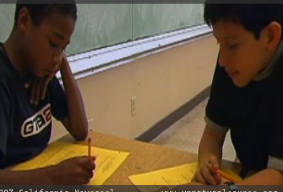 Youth Empowerment Strategies (YES!) Anti-Violence Program in Richmond, California Youth Empowerment Strategies (YES!) Anti-Violence Program in Richmond, California 
WEB-EXCLUSIVE VIDEO, Unnatural Causes Learn more about YES! - the after-school youth anti-violence program featured in "Place Matters."
|
 |
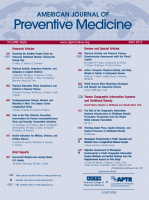 Zip Code as Important as Genetic Code in Childhood Obesity Zip Code as Important as Genetic Code in Childhood Obesity 
ARTICLE in Science Daily, 2012 Report on a new study that indicate that where a child lives, including factors such as the neighborhood's walkability, proximity to higher quality parks, and access to healthy food, has an important effect on obesity rates. |
 |
| « Prev 1 | 2 | 3 |
|




